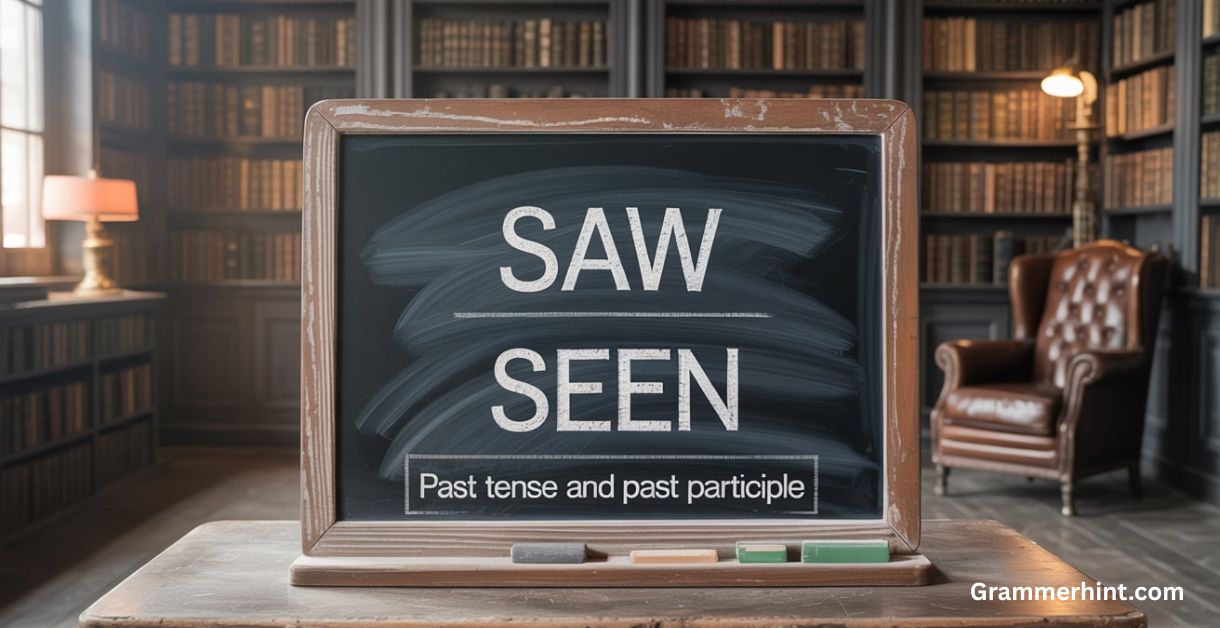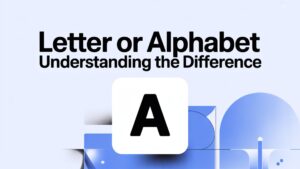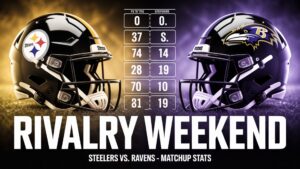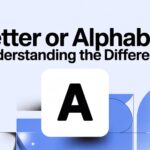In the world of English Grammar, verbs form the backbone of communication. But when it comes to verb conjugation, especially with irregular past tense verbs, things can get a little tricky.
One such verb is “see.” Learners often ask, “What is the past tense of see and its past participle?” Is it “saw“? Or “seen“? Let’s clear up the confusion once and for all and break this down with real life contextual grammar examples that stick.
Past Tense of ‘See’
How It Changes:
In standard English verb conjugation, the past form of see is saw.
- See (verb – base form) ✓
- Saw (past tense) ✓
- Seen (past participle) ✓
So, the see past tense is “saw“. That means, when referring to an action that happened in the past, without any connection to the present, you use saw.
For example:
- “I saw a bird outside my window yesterday.”
- “We saw a movie at the theater last week.”
- “Jessica saw a rainbow on her way to work.”
Why it Matters:
Using the correct tense is crucial for clear communication. Saying “I seen a movie” instead of “I saw a movie” can instantly flag your sentence as grammatically incorrect.
The past simple tense (also known as the past form of see) is used to talk about completed actions that happened at a specific time in the past.
Past Participle of ‘See’
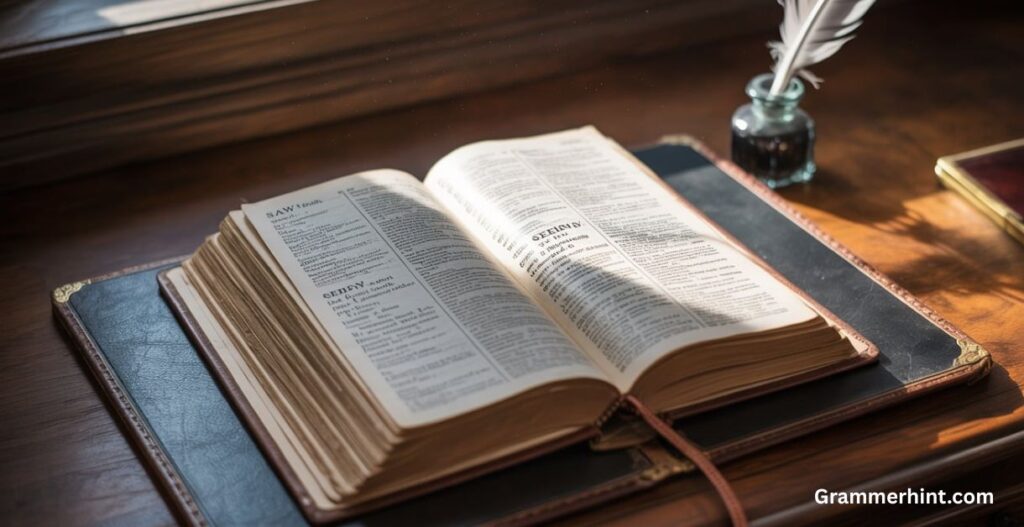
How It Changes:
The past participle of “see” is seen.
This form is often paired with auxiliary verbs like have or had to form the present perfect tense or past perfect tense.
Examples with auxiliary verbs:
- “I have seen a cat climb that tree before.”
- “We had seen that big tree long before the storm hit.”
- “She has seen a new restaurant open on Main Street.”
Why it Matters:
The past participle isn’t used alone. It always works with helping verbs to express something that happened before now, or something that’s been experienced or completed in the past, possibly with present relevance.
This distinction is key when learning grammar rules for see and for mastering grammar usage in sentences.
Common Mistakes to Avoid
Don’t Mix Up Words:
Many ESL learners confuse “seen vs saw.” Let’s break it down:
- Wrong: “I seen that movie yesterday.”
- Right: “I saw that movie yesterday.”
- Wrong: “Have you saw that dog before?”
- Right: “Have you seen that dog before?”
This is a common English mistake, especially among beginner learners or those unfamiliar with irregular past tense verbs.
Keep Tenses Right:
Mixing simple past tense and present perfect tense leads to awkward sentences. Always use saw for specific time references and seen when paired with helping verbs.
Time expressions for past tense:
- Yesterday
- Last week
- Last summer
Time expressions for past participle:
- Before now
- Already
- Ever/never
Grammar Tips for Learners
- Memorize the base, past, and past participle forms:
| Base Form | Past Tense | Past Participle |
|---|---|---|
| See | Saw | Seen |
- Understand verb transformation and how it fits different time expressions.
- Use storytelling in past tense to practice:
“Last summer, Maria and I saw a big tree while hiking. We had seen photos of it before, but witnessing it in real life was breathtaking.”
This natural mix of past simple and past perfect shows real-life application of verb tense rules.
Difference between Saw and Seen
This is one of the most asked questions in ESL grammar help forums.
| Form | Function | Example |
| Saw | Simple past (used alone) | “I saw a cat.” |
| Seen | Past participle (used with helping verb) | “I have seen a cat.” |
Ask yourself: Are you talking about something that happened once at a specific time? Use saw. Are you describing an experience or repeated action without a specific time? Use seen.
Verb Transformation in Context
Let’s look at a few more contextual grammar examples in different situations:
Business Email Example:
Subject: Feedback on the New Marketing Campaign
Hi Jessica,
I saw the presentation you gave last week, and I must say—it was impressive!
Also, I have seen similar campaigns in the past, but yours stood out for its clarity and energy.
Best, Mark
Casual Conversation:
Tom: Did you catch the eclipse?
Linda: Yeah! I saw it from the roof. It was amazing.
Tom: I missed it. But I have seen photos online.
Academic Writing:
According to observational data, researchers had seen a pattern emerge long before it became widespread.
These examples demonstrate how English language tense rules shift depending on tone, audience, and setting.
Using Past Tense in English
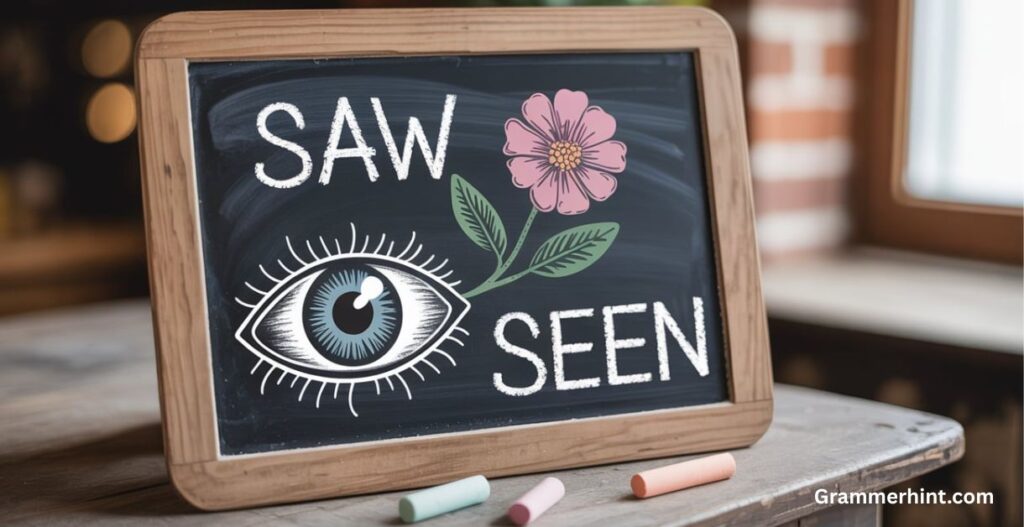
When writing or speaking in English, especially when telling stories or describing past events, the right verb tense shapes the meaning. Using the wrong form can confuse the listener or reader.
Consider these phrases:
- “We saw a new restaurant open in town.”
- “We have seen a new restaurant open, and it’s already crowded.”
The first shows a completed action, the second connects the past event to the present experience.
Simple Past Examples for Practice
| Sentence | Correct Form | Time Expression |
| I ___ a rainbow. | Saw | Yesterday |
| We ___ that movie before. | Have seen | Before now |
| She ___ a bird on her walk. | Saw | Last week |
| They ___ a ghost once. | Had seen | Years ago |
Practicing these types of simple past examples builds fluency and strengthens understanding of verb conjugation.
ESL Grammar Help Table: Saw vs Seen
| Use Case | Use “Saw” | Use “Seen” (with helper verb) |
| Action at a specific time | Yes | No |
| Experience over time | No | Yes |
| With “have” or “had” | No | Yes |
| Without helper verb | Yes | No |
This is a great reference for visual learners needing a quick English tense chart.
Conclusion
So, see ka past tense is clearly saw, and see ka past form is the same: saw. However, when using perfect tenses, the correct form is seen. Understanding this word change isn’t just about memorization. It’s about recognizing temporal reference in grammar, knowing when to use specific tense forms, and avoiding verb tense mistakes.
To recap:
- Use saw for completed, one-time actions in the past.
- Use seen only with helping verbs like have seen or had seen.
Now that you’ve got a handle on the grammar rules for see, you’re one step closer to mastering English Grammar and sounding more fluent, whether you’re writing an essay, an email, or just chatting with a friend.
